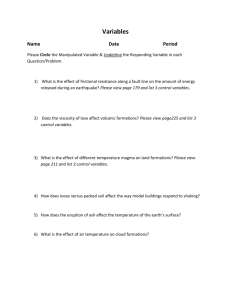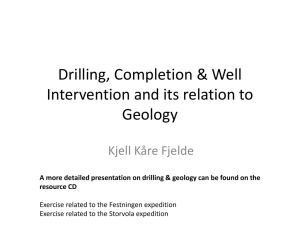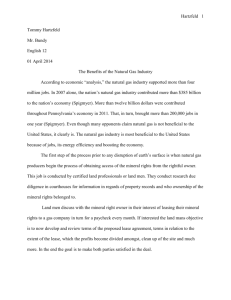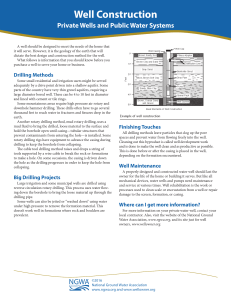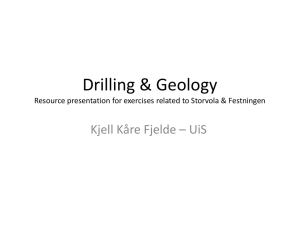Drilling, Completion & Well Intervention and its relation to Geology Kjell Kåre Fjelde
advertisement
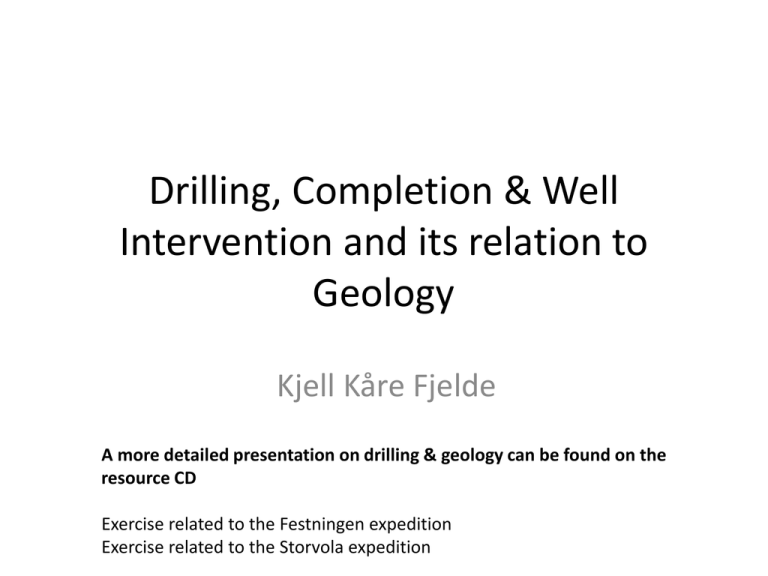
Drilling, Completion & Well Intervention and its relation to Geology Kjell Kåre Fjelde A more detailed presentation on drilling & geology can be found on the resource CD Exercise related to the Festningen expedition Exercise related to the Storvola expedition The different well phases • Drilling – Make the wells • Completion – Prepare the well for production – Different tools installed inside the well • Production – Earn money • Intervention – Fix well (damages or improve production) • P&A – Plug the well Drilling • Main objective: – Drill a hole in the ground as fast as possible without accidents West Phoenix – Dual ramrigg. Seadrill • Expensive – Rig rate – Rate of penetration www.nov.com - Rockforce www.nov.com – Uforseen events Must choose an – ++ appropriate drill bit depending on geology /formation hardness Kymera Hybrid bit Baker Hughes Tools www.nov.com Casing program • The well will be drilled in sections. When a section is drilled, a steel casing is set to protect the well before resuming drilling with a reduced hole size Control pressures Case of unstable formations Pressure Control • • • If Pwell < Ppore - > Potential kick If Pwell > Pfrac - > Potential losses i.e Ppore < Pwell < Pfrac • Pwell (bar) = d x 0,0981 x Htvd – d – density of mud i sg ( e.g 1500 kg/m3 =1.5sg) – Htvd – True vertical depth of well • The different hole sections will be drilled with different mud densities in order to control well pressures • This will also affect the casing design E.g.here we use a mudweight of 1.45 sg = 1450 kg/m3 Figure to be found in drilling programs. The lithology column tells us what formations that will be drilled through. The curves shows us the pore and fracture pressures and the mudweight we should use in the different hole sections Bit Choice & ROP • ROP (rate of penetration) tells us how fast we drill. – (1 m/ hour – very slow, 60 m / hour – quite good) • Low ROP - > Expensive operations. • ROP will depend on formation hardness & bit choice • Bit change (wear, failure etc) is time consuming & costs money • Important to choose the right bit for the formation to ensure – As high ROP as possible – Avoid wearing out the bits too early. – Bit types: (Roller Cone, PDC, Hybrid bits and Diamond Bit) Formation hardness • The choice of an approriate bit will depend on formation hardness & abrasiveness – Soft/Medium soft formation • Shale, clay, limestone, sands. – Medium hard/hard formation • Hard limestone, sandstone, dolomite – Hard and abrasive formations • Granites, basalts, quartzite and chert • Check www.adriatech.com for appropriate rock bits for the different formation types. Roller Cone • Steel tooth – Top hole, Soft formations • Tungsten carbid inserts – Medium to very hard formations – Formations where PDC does not work – Drill out shoe (cement) • Rate of penetration – Medium, Slow • Steerability – Good • More trips to change bit due to wear compared to using PDC bits. www.nov.com - Rockforce Be aware of: Cones can be lost (fishing operations) The cutters will be worn down Bearings is a weak point Gauge wear Bit balling (bit packed with formation) PDC (fixed cutter bit) • Soft to medium hard formations (not applicable in very hard & abrasive formations) • Shales are easier to drill (ROP) than limestone/sandstone and PDC bits usually drills twice as fast in shale compared to roller cone • Lower sections (12 ¼” hole ->) • Steerable and rotary applications (motor & RSS) • High ROP (opposed to roller cones) • More expensive • More robust (fewer trips compared to roller cone) • Steerability depends on design Figure taken from Vett & Viten Hybrid Bits (recent technology) • Combination of roller cone and PDC bit design (use the best of both) • Hard and interbedded formations - handles changes from soft to hard rock • Less vibrations • Increased ROP potential • Chert drilling Kymera Hybrid bit Baker Hughes Tools Natural Diamond Bits • Applicable for hard formations (e.g. where roller cone is too slow or har too short lifetime) • Not applicable for chert and pyrite (will break into pieces and may destroy the diamonds) • Not applicable for very hard broken formations (may break the diamonds) www.nov.com Directional Drilling • Directional drilling was a step change in development of oil & gas resources • Better drainage – Eg. the Troll field (exploit a wide but thin oil layer) – Drain several layers Hydro drilling for oil in Bergen Directional drilling • Avoid salt dome structures • Faults or hard formations layers – Cross with right angle • Multilaterals • Sidetracking Drilling problems • Three major problems that can occur during a drilling operation – Kick • Inflow of gas/oil in the well during operation • If not controlled, it can lead to a blowout – Lost Circulation • Mud losses to formation • Expensive • Can lead to a kick – Stuck pipe • If the drillstring is stuck, the worst case scenario might be to plug and make a sidetrack • Very expensive Deepwater Horizon – 21 April 2010.- Gulf of Mexico, www.wikipedia.org Kick • Kick - > unwanted inflow of gas, oil or water, if not controlled - > Blowout • Reasons: Uncertainty in pore pressure Too low mudweight Swab (during tripping or heave effects) Lost circulation (mud disappear) caused by too high well pressures causing fractures or drilling into caves. – Insufficient refill of well while tripping out. – – – – Barrier drawing from NORSOK D010. It shows the BOP (blowout preventor) which is a classified as a secondary barrier element. It is closed in case of a kick. A well control procedure is initiated and the kick is circulated out of the well using the chokeline and choke. Lost circulation • Can result in a reduced mudlevel in the well which again can cause a kick. • Reasons: – Naturally fractured formations (Karst, dolomite, limestone) – Too high ECD -> Fracture pressure exceeded • Reduce pump rate and mudweight – Surges • Avoid tripping to fast • Break mud gel before initiating circulation. Stuck Pipe • Stuck pipe is one of the more severe events that can occur during drilling and can lead to large costs – Fishing operation – In worst case, a sidetrack is the final solution. • Three main causes – Mechanical related – Formation related – Differential sticking (pressure related) Mechanical • • • • Key seating Poor hole cleaning Undergauge Wellbore geometry – Formation layers, change in hardness • Collapsed casing • Junk Formation related • Unconsolidated formations (e.g sand) • Boulders • Fractured formations (e.g. around a fault) • Mobile formations (e.g. salt) Formation related - Shale • Shale can cause som special problems: – Geo pressured shale (over pressured shale) • Requires a higher mudweight to control it. – Reactive shale (water from mud inhibits the shale and it swells) – lack of inhibition Completion • • After the well has been drilled it has to be completed and prepared for production A lot of equipment is installed in the well e.g. – – – – • Production tubing Production packer (fixes the production tubing inside last set casing) Downhole safety valve (SCSSV) Etc The reservoir has to be prepared for production – Different solutions exists Figure from NORSOKD010 showing the barrier elements in a production well Two major types of completion Cased hole completion. Use of perforation guns www.akersolutions.com Open hole completion EXCLUDER2000 Screen (15-30%) Figure from BakerHughes Use of sandscreens to protect the well from eroding sand Intelligent well completions • In these wells one can install valves and control lines which can control the production from different zones in one well. • Need less wells • Control water production – Water production is unwanted. Intelligent well completions • Using an intelligent well completion we can control the water production for instance by closing zones or by reducing water injection in zones where there is large water cut. Well Intervention • During the production phase there can be several reasons for performing a live well intervention operation: Scale removal (salts forming in the well) Azid stimulation (carbonates) Removing sand/cleaning sand screens Perform production logging to detect water producing formations that should be sealed – +++ – – – – • Most common methods (wireline or coiled tubing) Wireline Often used in conjunction with tractor to intervene in inclined sections. - www.akersolutions.com Wireline – example of application • One example could be to intervene in the well to find which formation layers that are producing water • One would need a braided (electric) wireline rig up, tractor and a production logging tool string. www.akersolutions.com Fullbore & Inline spinner The rotating speed will depend on which fluid that is present – Identify fluid type. Coiled Tubing • Use of a flexible string that can be run in and out of the well and fluids can be circulated • Used for instance for: www.nov.com – Azid stimulation (carbonates) – Sand cleanouts (e.g long horisontal wells with sand)/sandscreens www.slb.com The different well phases • Drilling – Make the wells • Completion – Prepare the well for production – Different tools installed inside the well • Production – Earn money • Intervention – Fix well (damages or improve production) • P&A – Plug the well
